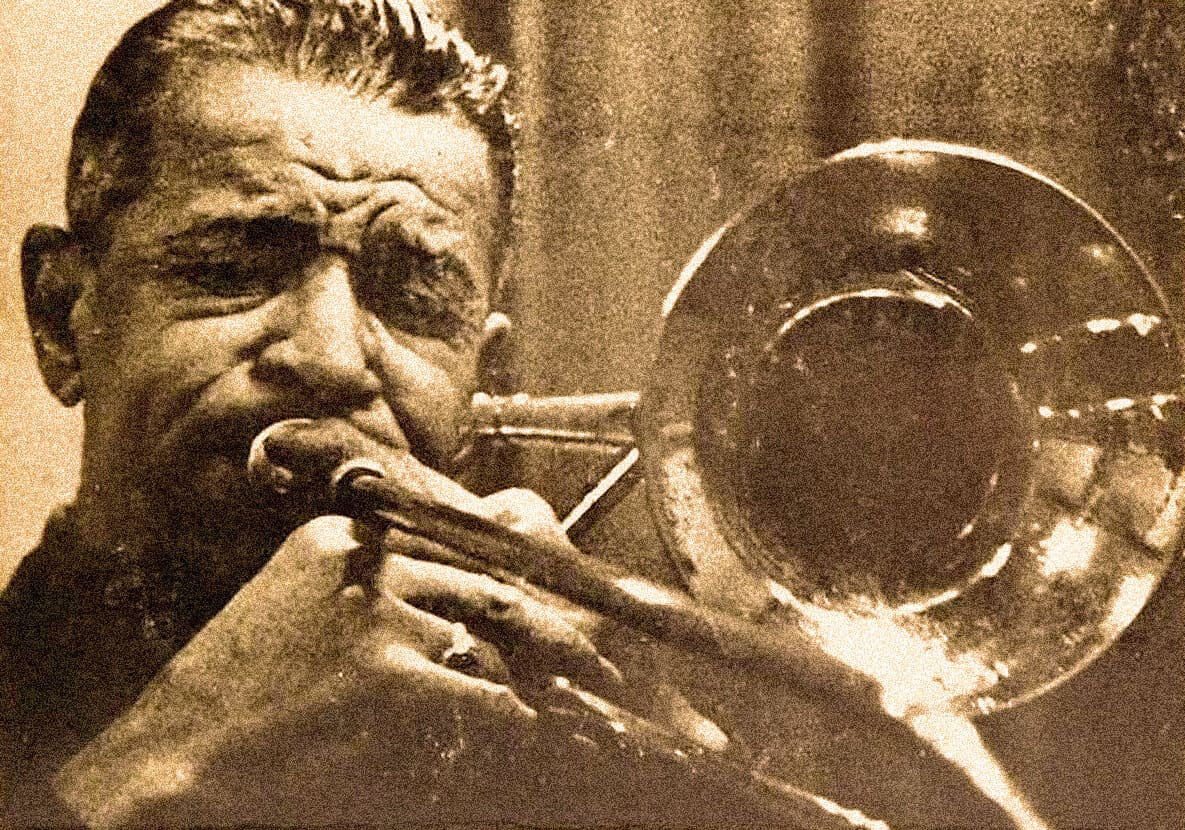
Kid Ory – live at The Beverly Cavern in Los Angeles and broadcast live over KGFJ and Armed Forces Radio in 1949. A lot of you, especially those of you just getting into Jazz, are going to listen to this and wonder what it’s doing here. You may not think this has a place alongside the John Coltrane’s, Sonny Rollins and Charles Mingus’s of the world. But you would be wrong – in fact Charles Mingus directly cites Kid Ory as a major influence in his musical upbringing.
Kid Ory was at Ground Zero – he goes back to the earliest days of Jazz; at its humble and raucous beginnings, in his band with the likes of King Oliver and Louis Armstrong which served as the launchpad for a number of Jazz greats who went on and forged paths of their own. This is the Roots Music of Jazz – much the same as just about every Rock Guitarist owes some level of playing or influence to Charlie Christian or Robert Johnson – it goes back that far.
Jazz is very much the same way. And even though you may want to dismiss this particular genre of music as “not very Jazz-like” from someone who may have grown up on a diet of Parker and Coltrane, you’d be missing the boat on one of the most essential elements – the springboard from which all that came later happened.
Kid Ory was an extraordinary musician with a long and legendary career. He was born in La Place, Louisiana in 1886. He started playing music with homemade instruments in his childhood, and by his teens was leading a well-regarded band in southeast Louisiana. He kept LaPlace, Louisiana, as his base of operations because of family obligations until his twenty-first birthday, when he moved his band to New Orleans. He was one of the most influential trombonists of early jazz.
Ory was a banjo player during his youth, and it is said that his ability to play the banjo helped him develop “tailgate”, a particular style of playing the trombone with a rhythmic line underneath the trumpets and cornets.
Ory had one of the best-known bands in New Orleans in the 1910s, hiring many of the great jazz musicians of the city, including the cornetists Joe “King” Oliver, Mutt Carey, and Louis Armstrong, who joined the band in 1919; and the clarinetists Johnny Dodds and Jimmie Noone.
In 1919, he moved to Los Angeles — one of a number of New Orleans musicians to do so near that time—and he recorded there in 1921 with a band that included Mutt Carey, the clarinetist and pianist Dink Johnson, and the string bassist Ed Garland. Garland and Carey were longtime associates who would still be playing with Ory during his 1940s comeback. While in Los Angeles, Ory and his band recorded two instrumentals, “Ory’s Creole Trombone” and “Society Blues”, as well as a number of songs. They were the first jazz recordings made on the West Coast by an African-American jazz band from New Orleans. His band recorded with Nordskog Records; Ory paid Nordskog for the pressings and then sold them with his own label, “Kid Ory’s Sunshine Orchestra”, at Spikes Brothers Music Store in Los Angeles.
In 1925, Ory moved to Chicago, where he was very active, working and recording with Louis Armstrong, Jelly Roll Morton, Oliver, Johnny Dodds, Bessie Smith, Ma Rainey, and many others. He mentored Benny Goodman and, later, Charles Mingus.
During the Great Depression Ory retired from music and did not play again until 1943. He ran a chicken farm in California. From 1944 to about 1961 he led one of the top New Orleans–style bands of the period. His sidemen during this period included, In addition to Carey and Garland, the trumpeters Alvin Alcorn and Teddy Buckner; the clarinetists Darnell Howard, Jimmie Noone, Albert Nicholas, Barney Bigard, and George Probert; the pianists Buster Wilson, Cedric Haywood, and Don Ewell; and the drummer Minor Hall. All but Buckner, Probert, and Ewell were originally from New Orleans.
The Ory band was an important force in reviving interest in New Orleans jazz, making popular 1940s radio broadcasts—among them a number of slots on The Orson Welles Almanac program (beginning March 15, 1944). In 1944–45 the group made a series of recordings for Crescent Records, which was founded by Nesuhi Ertegun for the express purpose of recording Ory’s band. Ory retired from music in 1966 and spent his last years in Hawaii, with the assistance of Trummy Young. Ory died in Honolulu on January 23, 1973. He was buried at Holy Cross Cemetery in Culver City, California.
So, as a way of adding to your historic perspective on Jazz (if you aren’t already familiar) or to give you a sample of what the rather extensive Jazz scene was sounding like in Los Angeles in the 1940s, here is a broadcast from June 28, 1949 featuring Kid Ory and his band at the legendary Beverly Cavern in L.A. (long since gone).
Music History – pivotal moments – prime examples.





